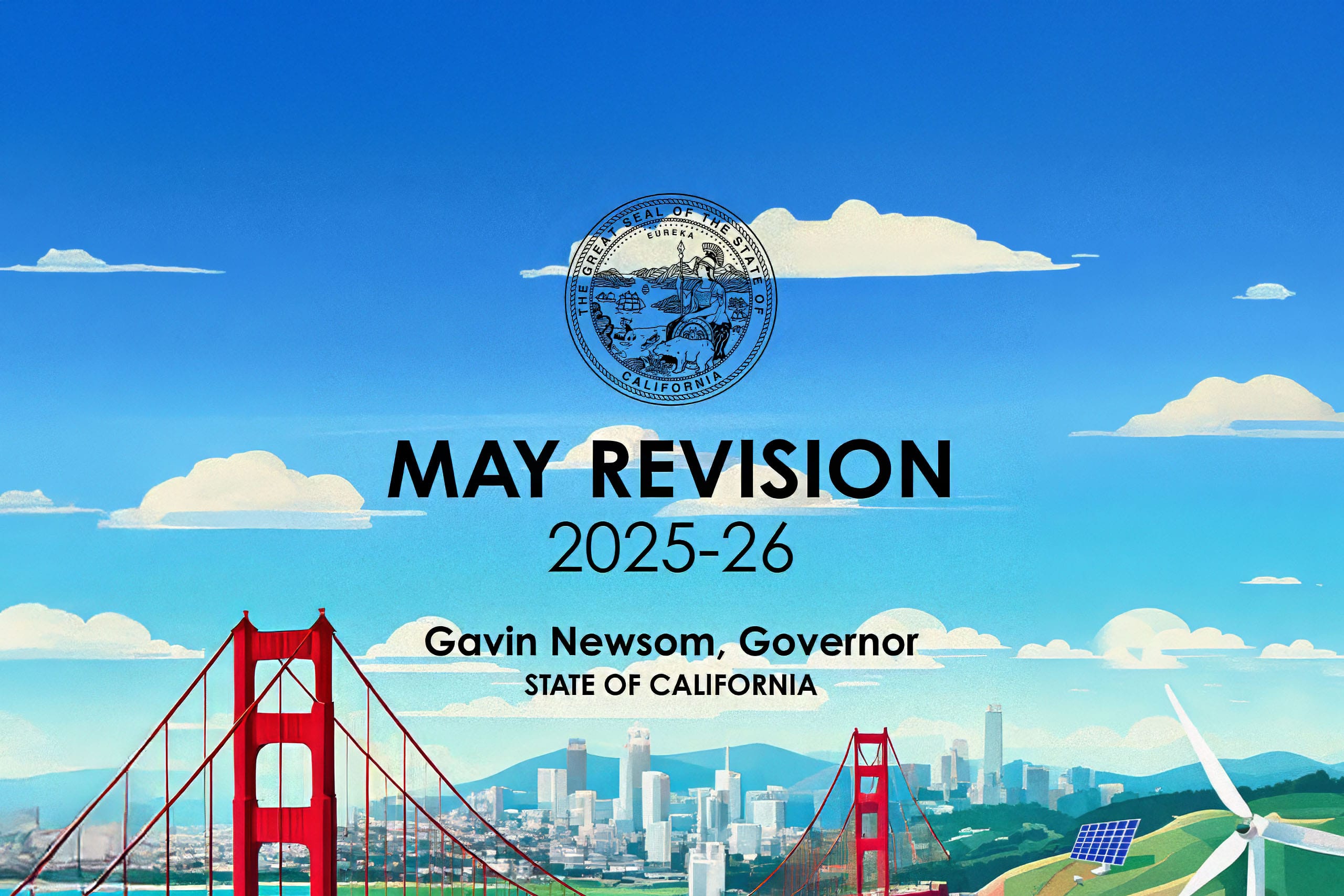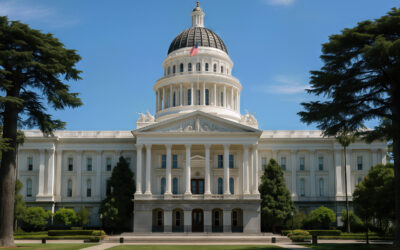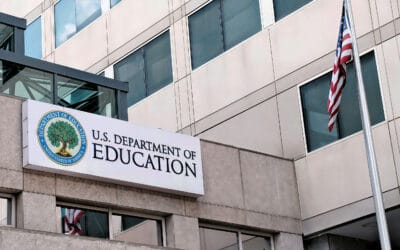Image courtesy of the California Governor’s Office, from the 2025–26 May Revision Budget Summary.
Today the Governor released his May Budget Revision. Although Governor Gavin Newsom announced declines in revenues and increases in costs that result in a substantial state budget deficit in 2025-26 and future years, the TK-12 budget remains largely unchanged from the proposal we saw in January. We will get to the details of Proposition 98 and the TK-12 budget shortly, but some of the school funding highlights include:
- A 2.3% COLA for LCFF and other programs that receive a COLA
- Continued support for the expansion and implementation of key programs such as Universal Transitional Kindergarten (UTK), universal school meals, and the Expanded Learning Opportunities Program (ELOP)
- $1.7 billion for a one-time discretionary block grant
While we commend the Governor for avoiding cuts, funding existing programs and limiting new commitments, we do note some issues that raise concerns or create future risks:
- The Administration proposes to appropriate $1.3 billion less than the currently calculated 2024-25 Prop. 98 Guarantee, which is inconsistent with past practice and potentially subject to legal challenge
- The funding level for 2025-26 relies on a $1.8 billion LCFF principal apportionment deferral from June 2026 to July 2026
- The current deposit and withdrawal triggers for the Prop. 98 reserve result in a zero balance in this reserve by the end of 2025-26
Political Context, General Fund Revenues, Expenditures and Reserves
Governor Newsom released the May Budget Revision this morning at a press conference designed to showcase the differences between California and the federal government. Newsom touted California as the best in the nation at business development and noted that California is now the 4 th largest economy in the world. Despite our progressive policies, Newsom argued that the California economy was outperforming almost every other state. Nevertheless, California is being hit by what Newsom deemed the “Trump Slump,” the decline in the stock market and economic indicators due to tariffs and trade policy volatility.
The Governor argued that the Trump Slump will reduce California revenue by $16 billion in budget year 2025-26. Most of that projected loss of revenue is based on lower capital gains revenue (largely stock market driven), but also on general weakness in personal income and corporate taxes. It is difficult to determine, however, the extent to which we are seeing a general negative trend in economic indicators versus a high level of (possibly temporary) volatility.
In addition to reduced revenues, Governor Newsom also highlighted increased costs to the state, particularly in the Medi-Cal program. Medi-Cal is the state’s health care program for low-income individuals, and the increased costs are both from higher enrollment and rising pharmacy and managed care costs. Newsom noted that only 5.3% of Medi-Cal costs can be attributed to undocumented individuals and argued that states with higher rates of uninsured residents simply pay higher emergency room and hospital costs.
The Administration estimates that the revenue and expenditure problems create a $12 billion deficit in 2025-26, and under current projections there will be deficits in the next several years as well. The Governor proposes a number of solutions to close the $12 billion deficit, including reduced spending (mostly related to Medi-Cal), some loans among various funds within the budget, and some limited fund shifts. The May Revision also retains the planned $7.1 billion withdrawal from the state’s general fund reserve (the Budget Stabilization Account, or BSA).
In terms of the specific general fund revenue, expenditure and reserve figures over the three-year budget period, the numbers compared to January are worse but not dramatically worse. The Department of Finance (DOF) calculates that revenues are down by about $5.2 billion over the budget period, with a combined $5.9 billion increase in 2023-24 and 2024-25 offset by an $11.1 billion decrease in 2025-26.
These numbers include adjusting revenues up by nearly $3 billion in the prior year, which is an unusually large prior year adjustment for May Revision (normally most of the adjustments to 2023-24 revenues should have been identified by January 2025, when the Governor’s Budget was released). Total 2025-26 general fund revenue, not counting reserve withdrawals and other fund shifts, is roughly $207 billion.
Total 2025-26 general fund expenditures are about $226 billion (note that we started with a $34 billion prior-year balance), roughly $2.5 billion less compared to January. There are very few new programs or expenditures in the proposed budget.
Accounting for the $7.1 billion BSA withdrawal mentioned above, by the end of 2025-26, roughly $11.2 billion will remain in the BSA. Including the proposed $4.5 billion in the discretionary general fund reserve, that leaves total general fund reserves at about $15.7 billion at the end of 2025-26.
Proposition 98, Adjustments, TK Rebench and Reserves
Over the three-year budget period, DOF calculates that the Proposition 98 Guarantee will be about $2.9 billion above the 2024 Budget Act, but $4.6 billion below the January Budget. The Guarantee calculations for each year are:
- 2023-24 $98.5 billion (Test 2, suspended)
- 2024-25 $118.9 billion (Test 1 and maintenance factor repayment)
- 2025-26 $114.6 billion (Test 1)
There are some interesting Prop. 98 dynamics based on the general fund revenue assumptions described above. Based on real-time revenue collections through the end of April 2025, it appeared as if revenues were up significantly in 2024-25 compared to 2023-24. If that had remained the case, Prop. 98 would have received a large bump in the current year because year-over-year revenue growth drives the amount of maintenance factor that needs to be repaid (remember that the suspension of the Prop. 98 Guarantee in 2023-24 created about $8 billion of maintenance factor, which is repaid when year-over-year revenues grow). DOF found that a significant amount of the revenue collected in fiscal year 2024-25 actually accrued to fiscal year 2023-24, a finding that results in less year-over-year revenue growth and therefore a smaller maintenance factor repayment in the current year (about $1 billion less than had been proposed in January).
Also of note, the increased revenue attributed to 2023-24 does not benefit Prop. 98 because the Guarantee was suspended that year. All of this is rather complicated, and we will explain it more fully in our budget workshops in a couple weeks. The bottom-line is that while we expected the decrease in the Prop. 98 Guarantee in 2025-26, we had hoped that decrease would be partially offset by an increase in the 2024-25 Guarantee.
The May Revision maintains the controversial proposal from the Administration to appropriate less than the calculated Guarantee in 2024-25. Recall that in January the Governor proposed to appropriate $1.6 billion less than the Guarantee to “mitigate the risk” of over-appropriation. The May Revision changes the amount withheld to $1.3 billion instead of $1.6 billion, without explaining the rationale for the change. This proposal to appropriate less than the calculated Guarantee is not consistent with past practice and may be subject to legal challenge. This practice could arguably be a work-around to avoid suspension, the typical process to appropriate less money than required by the relevant Prop. 98 formula for a given year.
The May Revision also addresses an interesting caveat of the TK rebenching of the Guarantee. The Governor notes that to this point the rebenched amount has been subject to the typical statutory split between TK-12 schools and community colleges, with community colleges in recent years getting 10.93% of the overall Guarantee. However, those rebenching funds should have been set aside specifically for the costs of implementing TK, and the state hopes to rectify that oversight by attributing $492.4 million of the Guarantee to TK-12 schools that has otherwise been made available to community colleges.
Finally, with regard to the Prop. 98 Reserve, recall that all of the $8.4 billion reserve was withdrawn in 2023-24 (when the Guarantee was suspended). The Governor’s January Budget projected an additional mandatory deposit into the Prop. 98 Reserve of $1.2 billion in 2024-25, but the May Revision capital gains calculations reduce that deposit to $540 million. The drop in the Prop. 98 Guarantee in the budget year (2025-26) requires a mandatory withdrawal of the full $540 million, leaving no balance in the Prop. 98 Reserve as of the end of the year.
LCFF, COLA and Deferrals
The May Revision includes the finalized COLA calculation of 2.3%, down slightly from the January COLA estimate of 2.43%. The 2.3% COLA is applied to school district and county office LCFFs, the LCFF Equity Multiplier, and also to specified categorical programs (including special education, child nutrition, etc.). There are no proposed policy changes related to the LCFF.
The May Revision includes a significant new principal apportionment deferral. Recall that smaller TK-12 deferrals were implemented and repaid in the three-year budget period. The Administration proposes deferring $1.8 billion in LCFF funding from June 2026 to July 2026. This deferral has the benefit of allowing full funding of the LCFF in the budget year, but creates a $1.8 billion obligation in 2026-27 (or future years if the deferral is rolled forward). While there is certainly caution needed when using one-time funds for ongoing purposes, the decision to under-appropriate the Prop. 98 Guarantee in the current year seems at odds with this decision to implement a deferral in the budget year.
Programmatic and Spending Proposals
Considering the major shifts in revenues since January, there are surprisingly few changes in what the Governor is proposing for TK-12 programmatic spending for 2025-26. While there are a few reductions, particularly to investments to support the Career Education Master Plan, the Governor is holding steady on investments around his major education programs.
Student Support and Professional Development Discretionary Block Grant
The Governor proposes to reduce the one-time Block Grant amount by $100 million, from $1.8 billion to $1.7 billion. We haven’t run specific calculations yet, but expect this funding equals just over $300 per ADA. The May Revision reiterates the following priorities for the block grant dollars:
- Professional development for teachers on the ELA/ELD Framework and the Literacy Roadmap
- Professional development for teachers on the Mathematics Framework
- Teacher recruitment and retention strategies
- Career Pathways and dual enrollment expansion efforts
The May Revision adds a requirement that all LEAs receiving Block Grant funds report final expenditures by September 30, 2029, and includes language to ensure fire-impacted schools in California aren’t penalized for any decreases in ADA.
Universal Transitional Kindergarten (UTK) and the California State Preschool Program (CSPP)
For the 2025-26 school year, which is the final year of the UTK rollout, the May Revision proposes a total ongoing investment of $2.1 billion (inclusive of prior year investments) to support full implementation of UTK. This is a slight downward adjustment from the January proposal ($2.4 billion), largely to account for adjusted ADA numbers.
As a reminder, current law requires TK classrooms to move from an average of 12:1 student-adult ratio to a 10:1 student-adult ratio beginning with the 2025-26 school year. In January, the Governor proposed $1.5 billion ongoing funds for this purpose. Similar to the funds for expansion of the program, the May Revision reduces this amount to $1.2 billion.
The Administration also appears to be aligning penalties for TK class sizes more closely to penalties related to staffing ratios and credentialing requirements – those penalties are generally based on how far away a school district is from meeting the requirements. Under the May Revision, class size penalties would similarly be based on how far a district is over the 24-per-class average.
For CSPP, the May Revision proposes to suspend the statutory COLA in 2025-26, resulting in a total of $29.5 million in savings for the state.
Universal Meals
The May Revision maintains the Governor’s commitment to fully fund the state’s Universal Meals program, providing an additional $90.7 million in ongoing funding (down from $106.3 million in January) for 2025-26.
Expanded Learning Opportunities Program (ELOP)
The Governor maintains his proposal from January to fully implement ELOP in 2025-26. This includes an additional $515.5 million in ongoing funding (an increase of $85.5 million from January) to expand the LEAs that will be required to offer ELOP-access to all their TK-6 students, to include LEAs with 55% unduplicated students or higher (previously 75% or higher).
In a major win for small and rural districts, the May Revision also includes an additional $10 million to increase the minimum ELOP grant amount from $50,000 to $100,000 per LEA.
Master Plan for Career Education
The Governor proposes several downward adjustments to various proposals around the Master Plan. Given the newness of this effort, and the scrutiny on every dollar being spent, these reductions are not particularly surprising.
- $25 million one-time for the Career Passport proposal (down from $50 million)
- $15 million one-time and $5 million ongoing for the Credit for Prior Learning initiative (down from $50 million and $7 million, respectively)
- $1 million one-time General Fund to support regional coordination for career education and training (down from $4 million)
- Withdraws proposal to provide $5 million ongoing General Fund for the Government Operations Agency to establish a state planning and coordinating body for TK-12, higher education, and various state agencies to coordinate and forecast workforce needs with career education.
Teacher Preparation and Professional Development
The May Revision proposes to repurpose a $150 million proposal for teacher loan repayment into a $100 million Student Teacher Stipend Program. The program would provide $10,000 stipends to student teachers who complete at least 500 hours of student teaching. To be eligible for the stipend, prospective educators would need to be candidates enrolled in a program of professional preparation for a preliminary multiple subject, single subject, education specialist or PK-3 early childhood education specialist instruction credentials. Intern credentials would not qualify for the funds. The program seems to be intended to be ongoing, though it would be contingent on an annual budget appropriation.
In addition, the May Revision proposes to add $14.2 million in unused funds to the Golden State Teacher Grant program, bringing the total investment to $64.2 million.
Lastly, in order to ease the transition from the highly-panned Reading Instruction Competency Assessment (RICA) to the Literacy Performance Assessment, the May Revision allows the Commission on Teacher Credentialing (CTC) to adopt an alternate assessment, provides credential candidates additional time to take and pass the RICA, and exempts credential candidates who received certain COVID-era waivers from the requirements to pass a teacher performance assessment and a reading instruction competence exam if they completed induction or two years of satisfactory teaching service by June 30, 2026.
Literacy Instruction
The Governor’s January Budget included $545 million to support various programs aimed at increasing and improving student literacy. His May Revision builds on those investments with an additional $210 million for the following proposals:
- $200 million one-time to support “evidence-based professional learning” for literacy instruction in elementary grades. In his budget presentation, the Governor directly tied this investment to the ongoing work that is being done with AB 1454 (Rivas), often referred to as the “science of reading” bill.
- $10 million one-time for a COE to partner with the University of California, San Francisco (UCSF) Dyslexia Center to expand the capacity of the state-developed reading difficulties screener, Multitudes, and to scale up the technical infrastructure supporting Multitudes for expanded use across the state.
The May Revision also includes trailer bill language to clarify that the $40 million proposed in January to support the K-2 reading difficulties screener required beginning 2025-26, may be used by LEAs “on any costs associated with the implementation of the screener.” Language released in February would have limited the funding uses to just procurement of the screening instruments or training of educators to administer the screenings.
Secondary School Redesign Pilot Program
One of the few totally new proposals in the May Revision is a $15 million initiative to develop and identify models of middle and high school redesign that do the following:
- Create structures to support strong relationships that ensure each student is well known
- Foster deeper learning and competencies focused on 21st century skills
- Provide personalized supports that enable student success and equitable outcomes.
The pilot, to be administered by a lead COE in collaboration with the California Collaborative for Educational Excellence, would conclude in 2029 with a report documenting the pilot’s findings and recommendations.




0 Comments